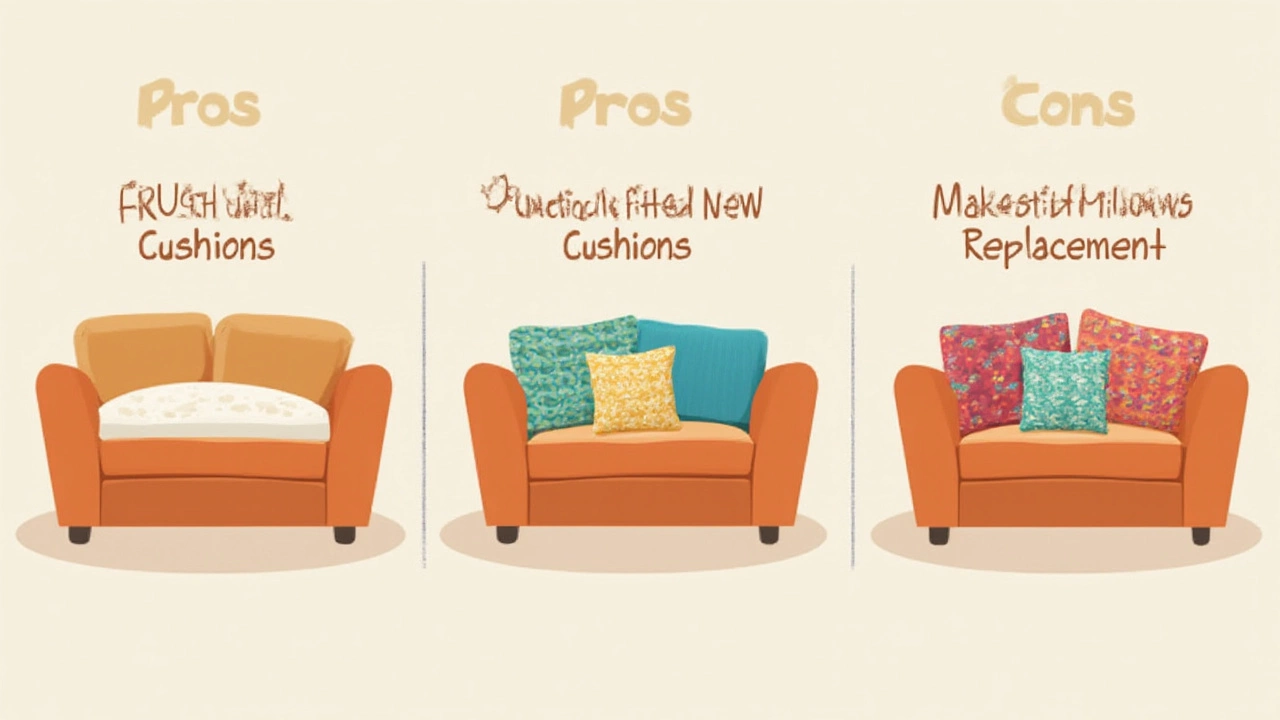
You’re staring at a lumpy, saggy couch, wondering if replacing the whole thing is the only way out. The couch frame is solid—the memories attached can’t be carted off. Can you just swap out the cushions and call it a day? Spoiler: Yes, you often can, and it’s way more doable (and affordable) than most folks think.
Why Couch Cushions Go Bad Before the Couch Does
Think about how your couch gets used: people flopping down after work, pets nesting in the corners, all those movie marathons with snacks ground into the fabric. The frame, the arms, even the legs often outlast what you plop down on. It’s the cushions feeling most of the action. According to an upholstery survey conducted by New Zealand’s Furniture Association in 2022, over 68% of people replaced or considered replacing their sofa due to cushion comfort—not busted frames, not broken springs. Cushions get worn out, lose their bounce, and sometimes pick up odours or stains that just won’t quit.
The good news? The vast majority of modern couches—especially those made in the past 25 years—are designed so you can remove the cushions. Even older sofas sometimes feature zippered covers or velcroed bottoms. Modular furniture and popular flat-pack brands like IKEA make it even simpler, selling replacement cushions separately. Yet, people toss out entire couches all the time just because those squishy blocks gave up the ghost. There’s an environmental impact too: in 2024, over 400,000 sofas were sent to New Zealand landfills, and at least a third could have been saved by cushion replacement.
But swapping cushions isn’t just about saving money or the planet. It’s a fast track to transforming how your living space feels without the hassle of moving furniture, coaxing a new couch through your door, or shelling out for delivery fees. Got a family heirloom with sentimental value? Replacing the cushions can genuinely give it new life—no special skills or tools needed in most cases.
How Cushion Replacement Actually Works
This isn’t a quick ‘rip and replace’ job—but it’s not rocket science either. Most couch cushions fall into two parts: the insert (that’s the foam, feathers, polyester, or whatever inside) and the cover (fabric, leather, or synthetic material). Both can usually be replaced. If the cushion covers have zips or removable sections, you’re in luck—slide the old insert out, shove the new one in, zip it up, and you’re done. Some inserts even come vacuum-packed; they puff up after a few hours.
If you’re dealing with fixed covers (no zips), things get trickier. You’ll need to either have the covers replaced by a professional upholsterer or learn some basic DIY upholstery skills. In Wellington, a typical reupholster job for a cushion cover costs around $45–$80 a piece, depending on the fabric. That’s still a far cry from shelling out $2000 for a new couch.
Choosing the right insert matters a lot. High-density foam has a lifespan of about 8-12 years, keeps its shape, and is the most common option. Down or feather inserts are luxurious but tend to flatten quickly and develop lumps unless you fluff them constantly. Some folks prefer a hybrid: foam core surrounded by polyester batting, for support plus softness. There’s also memory foam, which has become popular for people who want more support—especially for back pain.
When buying online, send precise measurements—not just overall width and depth, but thickness too. Here’s a cheat you didn’t know: if your old insert is too misshapen to measure, trace it onto a big piece of cardboard when you’re holding it as flat as possible. Then, measure the outline. Always go a little bigger with foam inserts, as they’ll compress to fit snuggly inside the cover (usually about 0.5 to 1cm larger).
Don’t forget about fabric. If you want to redo both covers and inserts, pick a tough but comfy upholstery fabric. According to a 2023 durability test by Consumer NZ, polyester-blend fabrics lasted about 20% longer than standard cotton or linen in abrasion tests, and stain resistance held up even after six months of daily use. You can even take advantage of fabric ‘remnant’ sales—leftover high-quality pieces from upholstery jobs at a fraction of the price.

The Cost Breakdown: Replacement vs. Buying New
You might be thinking, "Yeah, but is it actually cheaper to replace the cushions?" Time for the numbers. A surprising stat from a survey by NZ Home Living in January 2025 showed the average New Zealander spends about $1,800 on a good quality new sofa. By contrast, replacing all three seat cushions with high-density foam and custom covers typically costs about $350–$600 for the whole set, depending on fabric and size. Even if you need to fix up the back cushions too, you’ll rarely top $900 unless you’re opting for luxury materials.
Here’s a handy comparison, breaking down the basic cost in NZD (mid-2025 prices):
| Option | Estimated Cost (3 cushions) | Average Lifespan | Customisation Level |
|---|---|---|---|
| Replace inserts only | $180 - $250 | 8-12 years | Shape, firmness |
| New covers + inserts | $350 - $600 | 8-12 years | Fabric, colour, fit, firmness |
| New couch | $1,800+ | 8-15 years | None (as bought) |
Replacing just the cushions isn’t just gentler on your wallet—it means you can mix and match features that suit your lifestyle. Want waterproof covers for kids or fur-shedding pets? No problem. Prefer a firmer seat for your back? That’s easy to order. Need extra loft for guests who end up on the pull-out bed? Sorted.
Another perk: you can usually keep your old couch frame out of the landfill. The Ministry for the Environment in NZ estimated in 2024 that reusing or repairing household furniture saved about 53,000 tons of CO2-equivalent emissions compared to buying new. So beyond cost, it’s a win for sustainability.
Tips for Measuring, Ordering, and Fitting New Cushions
Buying replacement cushions sounds easy, but accuracy is everything if you want them to look and feel right. Here’s your cheat sheet for getting the job done like a pro (even if your last DIY project was assembling a flat-pack bookshelf that wobbles).
- Replace couch cushions only after you measure carefully. Remove the old insert from the cover and lay the cover flat—measure width, depth, and thickness (at the thickest point).
- Don’t just trust the specs online. Foam suppliers and upholstery shops work in centimetres, and it’s easy to fudge the number up or down. If your cover is stretched out, order the insert about 0.5-1cm larger for a snug fit.
- If the covers are shot, consider buying new ones made for your specific brand (like IKEA) or have local upholsterers sew custom covers—you can get wild with patterns and colours.
- If your back cushions are loose (the kind with stuffing inside), see if you can buy bulk polyester fill or down/feather blends and refill them yourself. This is usually cheaper than replacing the whole cushion.
- Pay attention to zippers. If yours always snag or split, consider swapping for heavy-duty upholstery zips. They’re cheap and make swapping inserts in and out less frustrating.
- If you can’t find a local supplier, check out NZ-based online foam shops—they have tools where you input sizes and shapes, and they cut to order. You can even send a physical template for oddly shaped cushions.
- When inserts arrive, give them time to expand—most foam or hybrid cushions arrive vacuum-packed and need hours (sometimes a full day) to reach full shape.
- If you want to save money, look for end-of-line foam cuts or fabric remnants. Some stores bundle these for cheap, perfect if your couch lives in a playroom or den and style isn’t the top priority.
- For people with allergies, look for hypoallergenic fills and choose covers that can handle hot washing.
- To boost longevity, rotate and flip cushions every few months. That distributes wear and keeps everything feeling even.
If you’re not sure your couch is worth saving, poke at the frame. If it doesn’t creak, wobble, or sag when you press the arms, replacing the cushions is almost certainly a smart move. If the frame’s shot, that’s when you might want to invest in a new sofa. But for most Kiwis, especially those with higher-end couches or solid timber frames, the fix is usually right there in the cushions.

When Should You Call in a Pro—and When Can You DIY?
Not everyone is keen to wield a staple gun or break out the sewing machine. Some cushion replacements are straightforward DIY projects, especially if you’re dealing with loose covers and standard foam inserts. Those require almost no tools except scissors and a measuring tape. You can order what you need online, pop the new cushions in, and enjoy your refreshed couch with a cold beverage in hand.
Things get tricky if your cushions are permanently attached or if you want a professional, seamless look (think piped edges, button tufting, or complex corner curves). Local upholsterers in Wellington have shared that about 40% of calls are from folks who tackled part of the job—only to get stuck lining up fabric or wrangling foam into oddly-shaped spaces. Sometimes, it’s a case of wasted materials; sometimes the cover shrank in the wash or ripped during stuffing. If you’re not sure, get a quote. Many pros are happy to offer advice, and consulting costs far less than a full redo.
Some shops in NZ even offer "DIY cushion kits", letting you choose fabric and foam and assemble at home. If you want to go fully bespoke—memory foam, wool blend, waterproof for outdoor couches—talk to a professional about materials and design. Don’t forget, insurance will often cover repair costs if your sofa is damaged due to a covered event (like flooding). Check your policy before dropping big bucks.
If you’re attached to your couch—maybe it’s the playspace for your kids, or your pet’s chosen nap spot—don’t give up just because the cushions are sad. Half a day’s work (and some online shopping) could save heaps of money, keep furniture out of landfills, and let you create exactly the couch experience you want.



